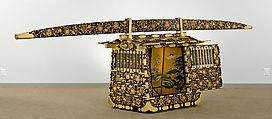Returned to lender The Met accepts temporary loans of art both for short-term exhibitions and for long-term display in its galleries.
Bridal Palanquin (Onna norimono) with Arabesque Foliage, Wild Ginger Leaves, and Family Crests (Owned by Princess Atsu-hime)
Not on view
This bridal palanquin was commissioned in 1856 to transport Atsu-hime (1836–1883), wife of the thirteenth Tokugawa shogun, Iesada. On the exterior is hiramaki-e arabesque foliage, the Tokugawa family crest consisting of three wild ginger leaves, and the flowering-peony crest of the Konoe family. The long beam would have been carried by six men as the princess made her way to the groom’s residence. The inside features a scene from Chapter 23 of The Tale of Genji, “First Song of Spring” (Hatsune) and two scenes from Chapter 24, “Butterflies” (Kochō), and the rear panel bears an image of the mythical paradisal island of Mount Hōrai. These views celebrated marriage, conveyed happiness, and carried auspicious meaning. They were also associated with ideal womanhood and suitable female conduct.
Due to rights restrictions, this image cannot be enlarged, viewed at full screen, or downloaded.
This artwork is meant to be viewed from right to left. Scroll left to view more.




